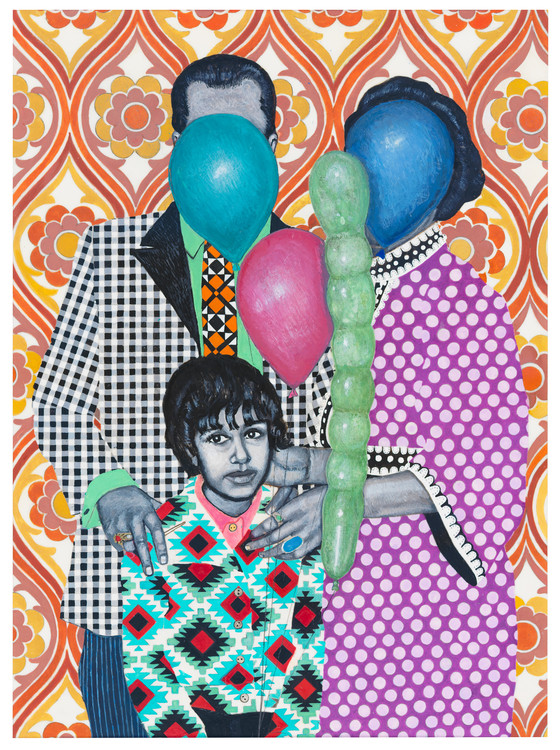In Soheila Sokhanvari’s Party People, a mother and father pose with their young daughter, though the faces of both parents are obscured by colorful balloons....
In Soheila Sokhanvari’s Party People, a mother and father pose with their young daughter, though the faces of both parents are obscured by colorful balloons. The flesh and hair of the figures is rendered in black-and-white, suggestive of the old family photograph that inspired the painting, which along with the sad-faced child, contrasts starkly with the festive patterns of their clothing and the backdrop behind them. The juxtaposition between bright colors and grayscale, and between the dimensionality of Sokhanvari’s photo-realism and the flatness of her invented patterns, places the work somewhere between the absurd and the tragic, between celebration and sorrow.
Accessing collective memory through individual narratives, the UK-based Sokhanvari collects family photo albums, expired passports, and archival images of Iranian pop icons that she uses as visual references in her paintings. The small size of her works approximates the unconventional portraits and photographic material upon which they are based, while their intimate scale as well as the dizzying array of patterns that pulse through them also evokes the tradition of Persian manuscript painting. While Persian miniature painting comprises opaque watercolor on paper, the rich colors of Sokhanvari’s work are the result of a laborious and time-consuming process in which she grinds pigments by hand, preparing her own egg tempera that is then meticulously applied to vellum. Sensitive to the politics of fashion and self-fashioning, Sokhanvari includes psychedelic patterns that hark back to the 1970s and the milieu of pre-revolutionary Iran that she experienced as a child in Shiraz, as visually recalled in the painting. By obscuring certain bodies or faces, Sokhanvari treats her paintings as memories themselves, with a mixture of joy, loss, nostalgia, and humor.
More...
